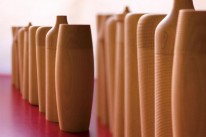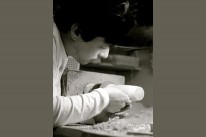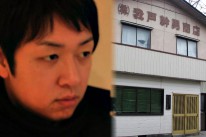GATO MIKIO CO.,LTD
Coporate Profille
Gato Mikio Co., Ltd was first established in 1908 as a woodworking plant in Yamanaka Onsen in Ishikawa Prefecture. Gato Mikio’s lacquer line shosen was coined by taking the kanji from the names of craftsmen Akio and Nobuo. The wiped lacquer technique was applied to the production of most shosen lacquer wares. The wiped lacquer technique involves painting a layer of lacquer, wiping it off, drying it, and then putting on another layer. This process is repeated several times before the lacquer ware’s completion. Therefore, raw wooden materials with the finest grains have to be selected and used. At Shosen, the best raw materials are selected, processed through the finest grinding technique, before carrying out the lacquer wiping process onto the items one by one.
Story
The origin of Yamanaka Lacquer ware is believed to appear during the Azuchi Momoyama period when the woodwork craftsmen moved to the upper stream of the Yamanaka Onsen. The goods then are not lacquered, but made from the raw materials of trees. The method of lacquering first came from Kyoto, but Yamanaka-styled lacquering was later created. Yamanaka Lacquer ware’s specialty is decorative grinding, which involves carving the wooden material into thin slices using the potters’ wheel method. There are more than ten types of techniques, including sensuji, itome-suji, rokurome-suji, inaho-suji, biri-suji and so on.
Interview
After graduating from high school, my first job is a warehouse dealer. I was in charge of the warehouse in Tokyo, and it was then I realized Yamanaka Lacquer ware such as bowls, sweet bowls and pots was an integral part of the lives of people living in the city. Yamanaka Lacquer ware is known as cheap goods in the market, but those were actually thinly lacquered goods. In fact, the thickly lacquered goods with a wide variety of design are the better-known Yamanaka Lacquer ware. I hope to continue developing items that integrate into people’s daily lives using the traditional techniques of Yamanaka Lacquer.
Recommendation
“Karmi” is a newly produced tea-leaf box created in 2010, where the characteristics of Yamanaka Lacquer ware are accentuated, yet perfectly blended into the needs of contemporary lifestyle. Special attention is given to the western tealeaf box due to the frequent use of expensive tea boxes in the west. The layers of lacquer are thinly painted in order to bring out the finely carved designs on the surface. This special design was presented with the “Design Plus Award” in an exhibition held in Germany in February of 2011. It is an object made of mizume wood, with finely cut designs known as sensuji and then processed with Yamanaka’s unique decorative carving. It is highly rated for its smooth cover designed by the craftsman, and its black shiny lacquer that suits the Nanbu Kettle. As the Karmi tealeaf box is relatively unaffected by the temperature and humidity from the air outside, the tea fragrance is well kept within the box.
There are several sizes of tea boxes available: capacity of 100 grams or 50 grams for preserving western tea; as well as capacity of 100 grams for Japanese tea. Prices range from 7,875 yen to 13,650 yen. The colours available are Soji (plain), Fuki (coloured) and Sumi (black).




